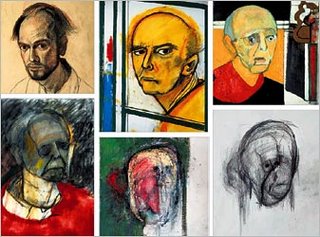 Art: Rarely does a painter make it to the front page of a major paper in the US. Today is an exception. The New York Times is running a piece on William Utermohlen documenting his descent into Alzheimers. Its a rather goofy article in some ways - trying to almost linearly equate the resulting images w/ the progression of neurological changes. Nonetheless, the images are interesting. I hope I get a chance to check out the show one day, though I have no trips to NYC planned in the next few weeks. Here's a snippet:
Art: Rarely does a painter make it to the front page of a major paper in the US. Today is an exception. The New York Times is running a piece on William Utermohlen documenting his descent into Alzheimers. Its a rather goofy article in some ways - trying to almost linearly equate the resulting images w/ the progression of neurological changes. Nonetheless, the images are interesting. I hope I get a chance to check out the show one day, though I have no trips to NYC planned in the next few weeks. Here's a snippet:The paintings starkly reveal the artist’s descent into dementia, as his world began to tilt, perspectives flattened and details melted away. His wife and his doctors said he seemed aware at times that technical flaws had crept into his work, but he could not figure out how to correct them.
“The spatial sense kept slipping, and I think he knew,” Professor Utermohlen said. A psychoanalyst wrote that the paintings depicted sadness, anxiety, resignation and feelings of feebleness and shame.
Dr. Bruce Miller, a neurologist at the University of California, San Francisco, who studies artistic creativity in people with brain diseases, said some patients could still produce powerful work.
“Alzheimer’s affects the right parietal lobe in particular, which is important for visualizing something internally and then putting it onto a canvas,” Dr. Miller said. “The art becomes more abstract, the images are blurrier and vague, more surrealistic. Sometimes there’s use of beautiful, subtle color.”


No comments:
Post a Comment